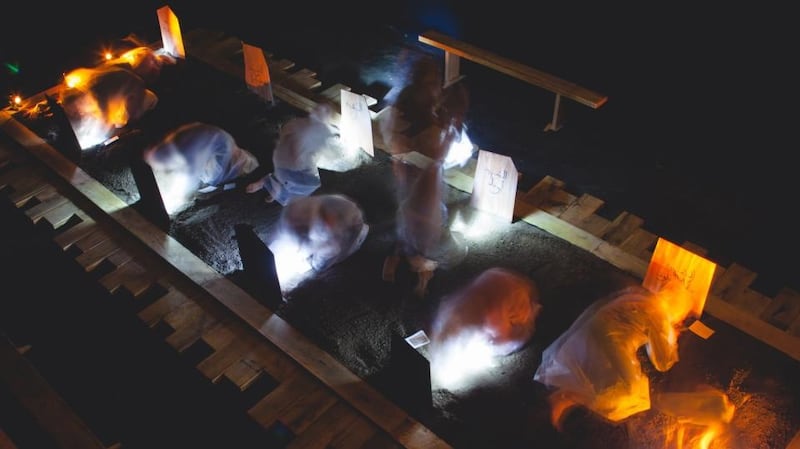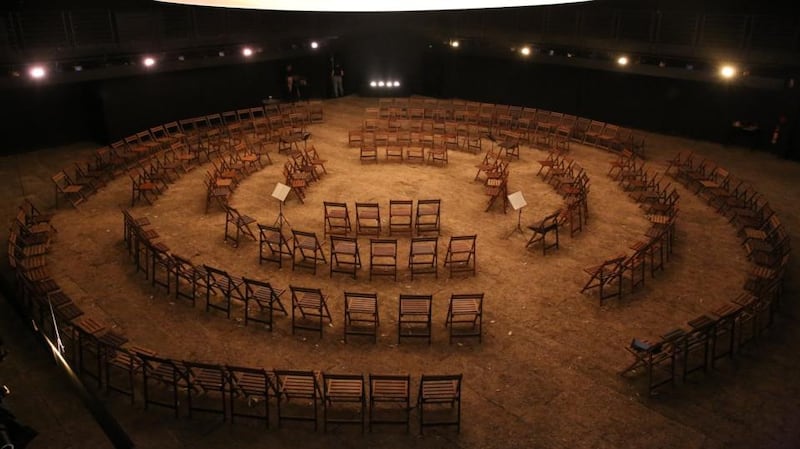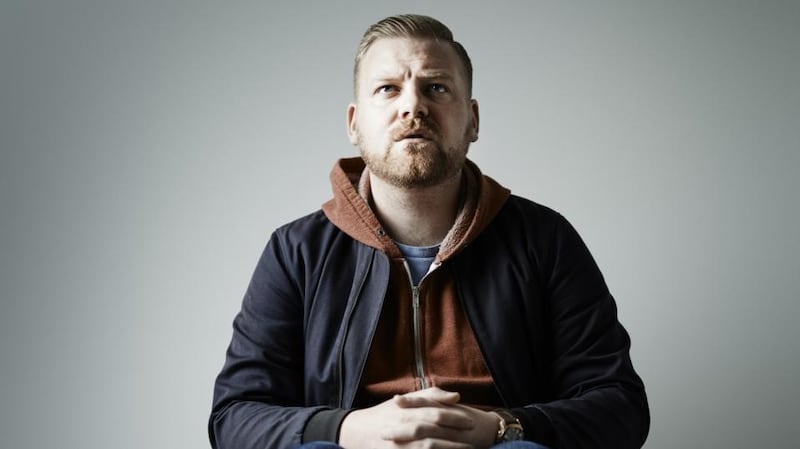It's a warm, damp night in the city, and they're everywhere. Why are so many people in Galway wandering around wearing red fezzes? Have they taken over from pink furry handcuffs for stags and hens? Nope. Madness are at the big top for Galway International Arts Festival (GIAF), and the merchandise tent must have done well. This festival is many things to a wide range of people, and these are some of them.
There are many prisms through which you can view GIAF, now in its mature phase, with 41 years under its belt, the past 13 under artistic director Paul Fahy.
You could gauge GIAF through the company it keeps – by way of its expanding partnerships and collaborations to create new work, which this year included a glorious burst of poetic intensity in Stanley Townsend's magnificent grief- and rage-laden performance in Paul Muldoon's Incantata produced with Jen Coppinger; David Mach's earth-shifting installation Rock 'n' Roll; associating with Irish National Opera on Orfeo ed Euridice; creating Enda Walsh's Office 33A.
0 of 4

The latter – an evocative room for a story imbued with sense of place – was one of a number of immersive experiences, another prism or thread defining this festival and broadening its strong theatre offering. Stories being what makes the world go round, finding new ways to tell them engagingly is a thrill.
If a physical place could drown in a multitude of experiences, NUIG’s theatre spaces were holding their breath to go under (in a good way), with a hive of stories in three distinct immersive shows.
Syrian stories
In Garden Speak the audience literally gets down and dirty (don't wear your best white jumpsuit) in a recreated graveyard, for an individualised experience. Tania El Khoury's production explores what lies beneath in Syria, where bodies of activists and protestors were buried in private gardens, ad hoc, early in the uprising. Ten people at a time don plastic macs and enter a small, dark cemetery to find a particular gravestone. In silence you dig, then lie in the dirt to hear the deceased's story, pressing your ear deep into the soil.
My story was that of Ahmed, a smart 23-year-old geography student who protested and whose dreams were wiped out by a sniper’s bullet. Ahmed’s friend dragged him to a garden where he buried him. The forgotten, unmarked burials of some of those lost cruelly and pointlessly in war are recalled in this moving and intimate show. As you lie in the earth, listening to a person from beyond the grave, this combination of oral history and installation makes real the stories behind headlines. The experience is stark, almost spiritual; it is dark and uncomfortable – in all senses, and rightly so.
Flight, another immersive story for our times, humanises migration. The stunning narrative – of two boys fleeing Afghanistan to make their way to London, and what happens along the way – is also a feat of technical virtuosity. The telling of this affecting tale is complex: every minute one audience member leaves as another joins, so 25 people are always sitting in small booths around a revolving carousel of windows where miniature vignettes light up to tell the story separately to those each viewing a different scene, aligned with the audio storyline on headphones. The message and the medium are spellbinding.
The festival's immersions were not confined to that trio at NUIG: the inflatable world of interlocking chambers of Miracoco Luminarium, the Alan Parkinson Architects of Air installation where thousands of people lost themselves in Eyre Square, was another; and Flaming Lips at the Big Top was an enveloping spectacle – they started by releasing massive balloons into the crowd while covering Space Oddity in a zorb, which then surfed the crowd.
Australia also figured across the festival, particularly in physical performance, with two top Aussie contemporary circus troupes. New-ish kids on the block Gravity & Other Myths' Backbone involved strength and people-towers and a sense of danger, while the longer-established Circa returned to the festival with Humans, Yaron Lifschitz's strenuously choreographed distillation of what a person is. The acrobats walk zombie-like then spring into action or freeze in virtuoso tableaux. Twosomes and threesomes of threading bodies weave through or leap over each other in tangles; others "play" with a trapeze. A female solo with the most – what? expressive – legs I have ever seen, is like a doll attempting to stand. The performers are muscular but also appear neat, light, smooth; then they land – thunk – on the floor and it almost hurts to watch.

Down at the Róisín Dubh four Australian women comprise the snappily-named indie band All Our Exes Live in Texas ("It's a lie," they confess), who delight the crowd with gorgeous harmonies and enormous charm despite the darkness of some material – songs about rejection (they introduce I'm Going to Cut my Heart Out, with a wry aside: "We also do weddings"), domestic violence, falling apart.
They are in tune with another dominant lens through which we can view the festival: women's strength and experience. It is there in Garden Speak, in the intellectually honest Wit, new writers at Druid; Mongoose's melodic, harmonic rock (one song was described "as if Joni Mitchell had written Bohemian Rhapsody") also at Róisín Dubh.
Triumph of transformation
A woman's life also figures in a big Australian theatre show, The Aspirations of Daise Morrow, set in a small community. Adapted from a short story by acclaimed Nobel-winning Australian writer Patrick White, it is set on both sides of the tracks in the run-up to the funeral of the eponymous free and sensuous spirit who scandalised her neighbours but was a redemptive life force. Its stagecraft is a triumph of transformation, turning the functional Black Box into a vast plain, with real grass over the entire auditorium, the audience in concentric circles around a small mound, a lighting rig evoking unrelenting sun, and an enormous low-hung moon or sky above it all. Four actors skilfully play an occasionally confusing range of characters (sometimes across gender), through shifting timescales. The action threads through the aisles and within and around the audience, which incorporates the Zephyr string quartet in its midst.

So, knockout staging and production; and yet. Not having read the – reputedly layered – story, most of us judge this purely on the play as presented. There is a nagging feeling it would have more impact for those familiar with the original, but as a stage production it must surely stand on its own merits. There are glorious turns of phrase in a script about love, death, redemption and compassion, involving large chunks of narration and description, and though often engaging, there’s more telling than showing going on. The characters are colourful and the language gorgeous, but the storyline seems almost slight for the epic setting.
Women's rights are just one of the manifestations of protest in Kenny Gallery's wide-ranging and provocative Art of Protest, incorporating social commentary and campaigning, political satire and street art, curated by artist Dean Kelly. The work ranges from Jim Fitzpatrick's Che to Shane Berkery's Donald Trump to Christopher Banahan's Margaret Thatcher (Wicked Witch of the West), to Dolores Lyne's Ironing for Ireland – a Repeal banner draped over an ironing board in protest preparation (with ironic teatowel prints also for sale).
Strong straight theatre offerings include excellent new plays at Druid, and Class, Iseult Golden and David Horan's belting three-hander set during a parent-teacher meeting, which takes unexpected turns. Flashing between the meeting and children in the classroom, the narrative encompasses educational philosophy, socioeconomic implications and personal relationships in a tense, nuanced, entertaining and confident drama.
Eclectic mix
Paul Fahy's 13th programme in Galway is its biggest yet – more productions, more attendances – pushing ever forward with an eclectic mix, from the First Thought talks to abstractions at Gallery 126 to RTÉ Concert Orchestra Proms followed by zipping electronic sets from Caribou in the Big Top. The festival has steadily increased its own original productions and this year saw innovations including the huge People Build Bridge Project, a "circus hub" in NUIG and the immediately popular Festival Garden.
Figures just crunched indicate GIAF this year broke a quarter of a million attendees for the first time, with 252,611 attendances at events (up from 210,000 last year). In addition, 145,000 attended the first year of the Festival Garden on Eyre Square.
On the mid-festival Saturday a queue formed before the Festival Gallery opened – rare enough for visual art – and that day alone 5,918 people visited the gallery, proving something about finding the right hook to grab public imagination.
So, as Galway gets into gear for this week’s races, and further down the line for a reign as Capital of Culture, it bids farewell to 2018’s arts festival. Look at it now as it departs: a multi-disciplinary arts festival in full maturity, confident, accomplished, with a wide appeal, skilfully curated straddling popular and more esoteric work, well able for production challenges. Nice one, well done, GIAF2018.
Technical daze: 9,032 lighting cues in one show
The production manager handed GIAF director Paul Fahy a potato in Hughes's pub in Galway at the weekend. It was the last potato as they struck the set from a regularly increasing mound of them in the corner of a busy and tech-heavy set for Incantata, one of the prides of this year's festival.
That show was technically impressive, and one of the striking features of GIAF18 is its skill in handling production challenges. In a city deficient in venues for performance or display, an accomplished team handled it all: daily set switches for two new productions in rep – Orfeo and Incantata at the Town Hall; the bamboozling demands of the glorious Flight (there are 9,032 lighting cues in the show); transforming disused space into a large airy gallery for several exhibitions, including David Mach's earth-excavating installation which took a month to install; and the impressive set for Daise which involved living grass over the entire floor.
Meantime, yesterday GIAF and NUI Galway announced a new multi-year partnership to provide cultural and creative opportunities for students. On foot of Galway as European Capital of Culture 2020 and the government's Creative Ireland, the festival will work with the university on education initiatives to complement NUIG's culture-related courses, including its new BA in music, ties will strengthen for GIAF's First Thought Talks, and the university will support new work by Irish artists to premier in Galway and tour. Festival chief executive John Crumlish described it as "a natural fit for the festival", while NUIG president Ciarán Ó hÓgartaigh said: "We see our cultural hinterland as central to our mission" and looked forward to supporting the "next generation of creative artists, producers and cultural entrepreneurs".























